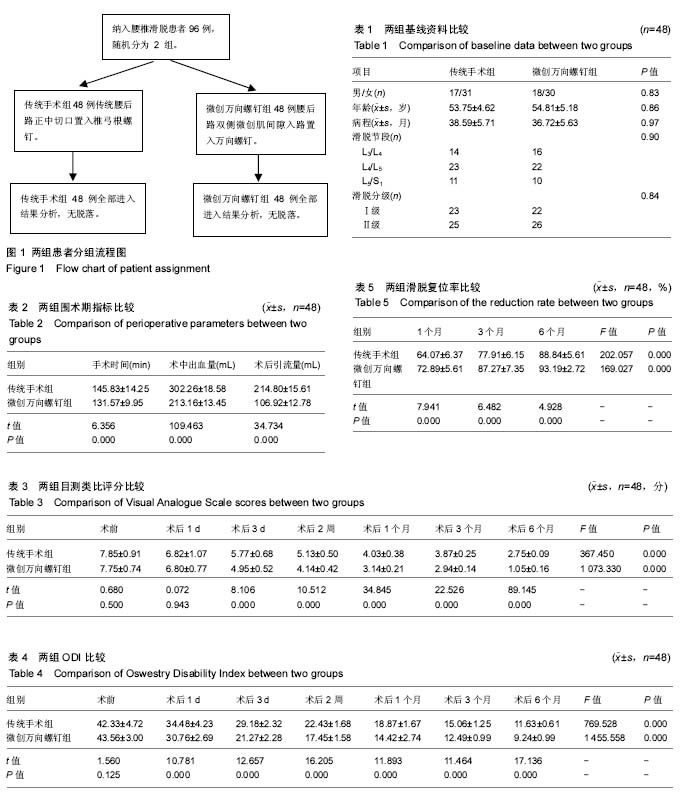| [1] 高爱国,赵鹏,张钦,等.微创经椎间孔腰椎间融合术治疗腰椎退变性疾病[J].临床骨科杂志,2016,19(2):141-143.[2] Young S,Lee JC,Choi SH,et al.Semi-circumferential decompression: microsurgical total en-bloc ligamentum flavectomy to treat lumbar spinal stenosis with grade i degenerative spondylolisthesis.Clin Orthop Surg. 2015;7(4):470-475.[3] 张峰,李展奇,牒军,等.后外侧植骨与椎间植骨融合术治疗腰椎滑脱症的远期疗效比较[J].实用临床医药杂志, 2016,20(5):76-78,99.[4] Wang J, Zhou Y, Zhang ZF, et al.Comparison of the clinical outcome in overweight or obese patients after minimally invasive versus open transforaminal lumbar interbody fusion.J Spinal Disord Tech. 2014; 27(4):202-206.[5] 中华中医药学会.临床诊疗指南•骨科分册[M].北京:人民卫生出版社, 2010:104-105.[6] Chao H, Kuo PY,Chang JC,et al. Dynamic stabilization for L4-5 spondylolisthesis: comparison with minimally invasive transforaminal lumbar interbody fusion with more than 2 years of follow-up.Neurosurg Focus. 2016;40(1):E3.[7] Abhijit Y, Pawar AP, Hughes AA,et al. A comparative study of lateral lumbar interbody fusion and posterior lumbar interbody fusion in degenerative lumbar spondylolisthesis. Asian Spine J. 2015;9(5): 668-674.[8] 北京协和医院.骨科治疗常规[M].北京:人民卫生出版社,2004:305-307. [9] 张炼.伤椎椎弓根螺钉固定横突间植骨在胸腰段爆裂骨折中的应用[J].中国临床研究,2015,28(9):1170-1172.[10] 张国强,陈学明,于振山.单纯减压与减压融合内固定术治疗伴Ⅰ度退行性滑脱的腰椎管狭窄症疗效比较[J].中国临床研究,2015,28(9):1199-1201.[11] 李少辉,王平均,连文文,等.退行性腰椎滑脱症内固定后出现反复下腰痛原因分析[J].颈腰痛杂志,2017,38(1):86-87.[12] Brotis AG,Patterakis KN,Tsiamalou PM,et al. Instrumented posterior lumbar fusion outcomes for lumbar degenerative disorders in a Southern European, Semirural Population. J Spinal Disord Tech. 2010;23(7):444-450.[13] Feffer HL,Wiesel SW,Cuckler JM,et al. Degenerative spondylolisthesis To fuse or not to fuse. Spine (Phila Pa 1976). 1985;10(3): 287-289.[14] 王长昇,林建华,许卫红,等. 脊柱微创通道镜系统辅助改良经椎间孔腰椎椎间融合术治疗腰椎退行性疾病[J].中国微创外科杂志, 2016,16(4):340-343.[15] 周跃,王健,初同伟,等.内窥镜下经X-Tube单侧和双侧腰椎椎弓根螺钉固定的疗效评价[J].中华创伤杂志,2007,23(9):654-658.[16] Selznick LA,Shamji MF,Isaacs RE.Minimally invasive interbody fusion for revision lumbar surgery: technical feasibility and safety. J Spinal Disord Tech. 2009;23(3):207-213.[17] 黎建文,黎松波,刘先银,等.微创可扩张通道下经椎间孔入路腰椎椎间植骨融合术治疗峡部裂性腰椎滑脱症的效果[J].广东医学,2016,37(4): 536-538.[18] 张猛,潘玉林,李伟,等.万向椎弓根螺钉在峡部裂型腰椎滑脱症手术复位中的应用效果[J].中华实用诊断与治疗杂志,2017,31(1):33-35.[19] 赵红卫,程云忠,刘扬,等.微切口经皮椎弓根螺钉技术在腰椎微创融合手术中的应用[J].骨科,2016,7(2):76-81.[20] Goldstein CL, Macwan K, Sundararajan K, et al.Comparative outcomes of minimally invasive surgery for posterior lumbar fusion: a systematic review.Clin Orthop Relat Res. 2014;472(6):1727-1737.[21] 王甫刚,周军,戴军,等.微创经椎间孔椎体间融合术治疗腰椎滑脱症的效果分析[J].中国骨与关节损伤杂志, 2016,31(11):1196-1197.[22] Yahya C, Erbas S, Pusat E,et al.Posterior lumbar stabilization surgery under spinal anesthesia for high-risk patients with degenerative spondylolisthesis, spinal stenosis and lumbar compression fracture. Turk Neurosurg. 2015;25(5):771-775.[23] 沈洪弟,崔烨平,魏志祥,等.经肌间隙入路椎间孔椎体间融合术治疗腰椎滑脱症[J].临床骨科杂志,2016,19(1):31-33.[24] Kapural L, Peterson E, Provenzano DA, et al. Clinical evidence for spinal cord stimulation for Failed Back Surgery Syndrome (FBSS): systematic review. Spine. 2017;42 Supplement 14:S61-S66.[25] Amirdelfan K, Webster L, Poree L, et al. Treatment options for failed back surgery syndrome patients with refractory chronic pain: an evidence based approach. Spine. 2017;42 Supplement 14:S41-S52.[26] Carneiro J, Santos J, Ferreira G, et al. Experience in Implantable Neuromodulation in Failed Back Surgery Syndrome at a University Hospital in Portugal: WIP16-0500. Pain Practice. 2016;16 Supplement 1:47-48.[27] El-Badawy MA, El M, Dalia ME, et al. Sympathetic dysfunction in patients with chronic low back pain and failed back surgery syndrome. Clin J Pain. 2016;32(3):226-231.[28] Shamji MF, Shcharinsky AR. 184 Use of neuropathic pain questionnaires in predicting the development of failed back surgery syndrome following lumbar discectomy for radiculopathy. Neurosurgery. 2015; 62 Supplement 1:227.[29] Snyder LA, O'Toole J, Eichholz KM, et al. The technological development of minimally invasive spine surgery.Biomed Res Int. 2014;2014(1):85-117.[30] Ma Z, Zhao C, Zhang K, et al. Modified lumbosacral angle and modified pelvic incidence as new parameters for management of pediatric high-grade spondylolisthesis. Clin Spine Surg. 2017. doi: 10.1097/BSD.0000000000000595. [Epub ahead of print] [31] 贺聚良,詹新立,肖增明.不同植骨材料及方法对腰椎滑脱植骨融合的影响[J].中国组织工程研究与临床康复,2009,13(16): 3153-3156.[32] Radcliff KE, Kalantar SB, Reitman CA. Surgical management of spondylolysis and spondylolisthesis in athletes: indications and return to play. Curr Sports Med Rep. 2009;8(1):35-40.[33] 任佳彬,孙兆忠,房清敏,等.微创经椎间孔及后路腰椎椎间融合术对腰椎滑脱症患者术后隐性失血的影响[J].现代生物医学进展,2016,16(12): 2306-2308,2362.[34] 雍明,吴继功,马华松,等. 万向椎弓根钉在不同矢状角下把持力的生物力学测试[J]. 安徽医学,2011,32(08):1110-1112.[35] Sebastian AS,Rihn JA,Wagner SC,et al. Should TLIF be routinely used in a 60-year-old man with a mild degenerative spondylolisthesis? Clin Spine Surg. 2017;30(10):429-432.[36] Nicholls FH, Bae J, Theologis AA, et al. Factors associated with the development of and revision for proximal junctional kyphosis in 440 consecutive adult spinal deformity patients. Spine. 2017;42(22): 1693-1698.[37] 唐恒涛,吴学建.经肌间隙入路微创治疗腰椎滑脱症的疗效[J].中华实验外科杂志,2015,32(7):1736-1739.[38] 潘玉林,焦云龙,张华,等. 短尾万向联合长尾单向椎弓根螺钉在峡部裂性腰椎滑脱症中的应用[J]. 中国骨科临床与基础研究杂志,2014,6(1): 27-31.[39] Lopez AJ, Scheer JK, Dahdaleh NS, et al. Lumbar spinous process fixation and fusion: a systematic review and critical analysis of an emerging spinal technology. Clin Spine Surg. 2017;30(9): E1279-E1288.[40] Safaee MM, Osorio JA, Verma K, et al. Proximal junctional kyphosis prevention strategies: a video technique guide. Oper Neurosurg (Hagerstown). 2017;13(5):581-585. [41] Di CJ, Somani S, Kim JS, et al. Analysis of risk factors for major complications following elective posterior lumbar fusion. Spine. 2017;42(17):1347-1354. |
.jpg)


.jpg)